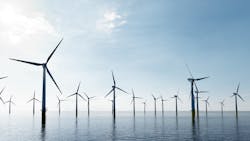Transforming the Grid, the Supply Chain and the Economy with Offshore Wind
Offshore wind is positioned to become an increasingly important source of energy in the U.S. over the next decade. As the offshore wind industry grows in the U.S., it could mean more jobs, big investments, and the development of local economies. For offshore wind projects to succeed, the industry needs to pursue a two-pronged strategy, developing the domestic supply chain over time while taking advantage of existing and well-proven experience and supply chains developed in other markets, notably Europe. The good news is that the technologies needed to deliver on the promise of offshore wind in the U.S. already exist — we simply need to put in place the plans and policies required to meet the aggressive timelines associated with the country’s greenhouse gas emission reduction goals.
Increased volumes of power from U.S. offshore wind and its impact on the grid
Over the next several years, the offshore wind industry could transform the way the U.S. gets its power. The U.S. is targeting more than 30GW of annual generation capacity by 2030 with upside growth opportunities as a part of President Biden’s Build Back Better plan. The Biden Administration’s plan includes a proposal to develop offshore wind farms on the East and West coasts and in the Gulf of Mexico — a significant step for America’s clean energy future.
Efforts to make U.S. electric grids more flexible and resilient are imperative to deliver on this promise, as the impact on the grid of the introduction of large volumes of renewable power will be significant. For instance, current plans call for the development of up to 6GW worth of capacity off the coasts of Long Island, all of which will need to be delivered through onshore connection points to local off-takers. That would mean by 2030, this region, which has always imported electricity, would become a net exporter of power, which is a very consequential shift. As the U.S. invests more into the offshore wind industry and becomes a bigger player in the space, the overall impact on the grid will be felt throughout the country and region.
Developing domestic offshore wind projects leveraging successful global models
There is a great deal of focus on developing the domestic supply chain for offshore wind opportunities, which is an important strategy for establishing the industry on a sustainable, long-term path. However, to meet the energy goals currently envisioned, it will be essential to take advantage of the existing supply chain that’s been developed in other parts of the world — most notably Europe — as the domestic supply chain is developing.
Most people think of offshore wind as simply turbines and blades, but there is an extensive ecosystem of interconnected technologies and infrastructure that need to work seamlessly together to deliver power to where it is needed, efficiently and reliably. From offshore substations to transmission technologies such as High-Voltage, Direct Current (HVDC) and Flexible Alternating Current Transmission Systems (FACTS) to sophisticated battery energy storage systems, integrating all the components needed to successfully introduce this new, variable power source at scale is a complex undertaking. However, there are models we can follow, such as the world’s largest wind farm in the UK, which is using HVDC technology to support extremely high-capacity links to deliver power to the mainland to power millions of homes. By following examples like this, that demonstrate successful deployment strategies and leverage proven end-customer solutions, there is an opportunity to shorten the learning curve for projects here in the U.S.
Supporting local economies as the offshore wind industry expands
While the technologies needed to make offshore wind possible are available and proven to be effective, there are challenges when establishing new offshore wind locations that cannot be solved with technology. Substantial investments, coordination, and planning initiatives are needed across federal and state governments, developers, and utilities in local communities to make projects successful. The federal government is throwing its support behind the offshore wind industry and many state organizations are also actively promoting offshore wind projects. If the industry is to truly thrive, public support and cooperation from local, impacted communities will also be needed.
This could be the catalyst for major economic opportunities in a variety of fields, from construction and manufacturing to high-end engineering jobs as well as local capabilities such as warehousing, assembly, transport, logistics, and 'blue water' industries such as ports and underwater construction.
Preparing for impact
The offshore wind industry will not only impact energy generation but will also help drive the transformation of the grid and boost economies and job markets where it is introduced. The ability to leverage well-established international supply chains while building local capabilities, coupled with the deployment of a variety of new grid innovations, will play a major role in ensuring the success of this critical component of a more sustainable energy system.
Anthony Allard is executive vice-president, managing director, United States and head of Hitachi ABB Power Grids' business in North America.
About the Author
Anthony Allard
Anthony Allard is executive vice-president, managing director, United States and head of Hitachi ABB Power Grids' business in North America.
